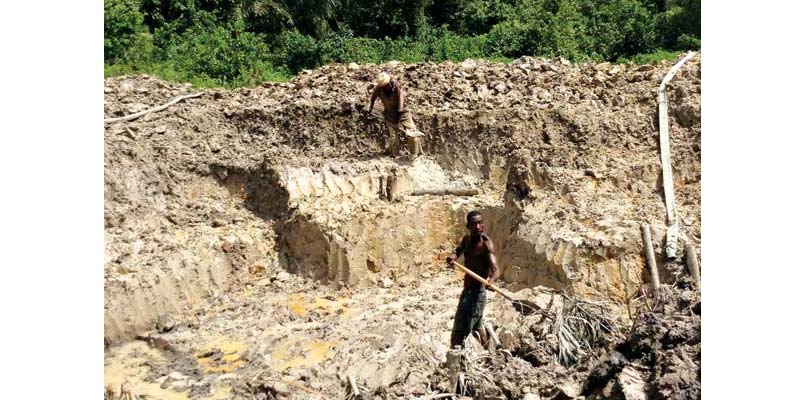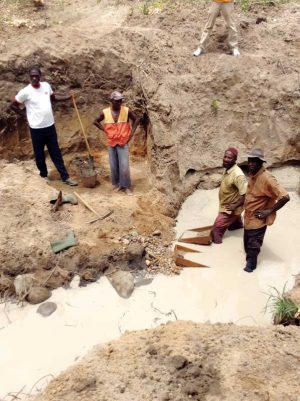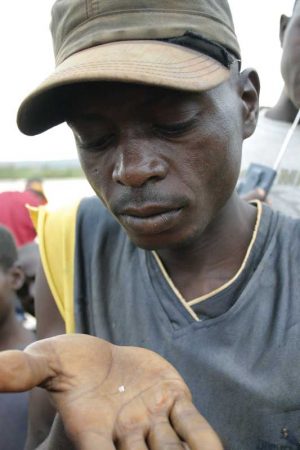Pointing the smoking gun on trading centres: Mounting evidence of unethical practices leads to calls for reform
by jacquie_dealmeida | July 29, 2016 9:00 am
By Alan Martin

As the sun and heat poured over me, I walked closer to the edge of the pit. I was in Liberia’s diamond country, and steppes of shovelled rocks had been dug out of the surrounding forest.
The two miners didn’t miss a beat. Shovelling away the heavy dirt, they didn’t lose out hope that today they would find a diamond.
For two months they’ve been digging. For two months they’ve come home empty-handed.
The conditions in which these miners work is Dickensian and all too familiar in artisanal diamond mines across the African continent: the pay is low, exploitation is high, and smuggling rife.
Like artisanal miners, African producers are also increasingly asking questions about how a valuable commodity like diamonds can return so little economic benefit to their country. In recent years, a range of developmental and social issues have come to the fore. Prime among them are ways in which the nature of conflict in the diamond sector has changed, or how complex things, such as transfer pricing and undervaluation in the supply chain, rob African producers of their mineral wealth.
The failure of the Kimberley Process (KP) to take action and address these major issues is leading to broader questions regarding the effectiveness of the entire system.
Nations—including Canada—are now asking, how do we move forward from here?
Diamonds and Dubai

When the Kimberley Process was conceived almost 15 years ago, it was one of the first multi-stakeholder initiatives to tackle a common problem—how a high-value mineral was fuelling horrific civil wars in several parts of Africa. The very foundation of the scheme comprised the collaboration of governments, industry, and civil society. But today, that foundation is slowly crumbling.
Our role as civil society has been the watchdogs and the eyes on the ground. After the KP was established, we monitored developments and highlighted abuses in the system. As the diamond industry continues to be tainted by links between conflict and illicit financing, civil society steps up to investigate and address these serious issues.
For example, on my visit to Liberia in 2013—and more recently to Sierra Leone earlier this year—I met with policymakers who were eager to comply with Kimberley Process export requirements, but still struggled due to a lack of capacity and training. I also spoke with miners and exporters who were eager to operate legally and within the system, but didn’t have the proper information—or capital—to be able to participate in the formal economy.
More importantly, diamond-producing countries are increasingly aware they are losing out on their diamond wealth. Diamonds are flowing to Dubai—a major trading hub—and re-exported at inexplicably higher prices. Policymakers are at a loss over what to do about it.
Since the formation of the Kimberley Process, Dubai has shot from obscurity to become the third-largest diamond trading hub in the world, last year trading $40 billion U.S. worth of diamonds. Companies in its jurisdictions also engage in a practice known as transfer pricing, which results in smaller revenues for Africa’s diamond-producing countries. Recent Kimberley Process statistics, a 2013 report by the Financial Action Task Force (FATF), and Partnership Africa Canada’s (PAC’s) 2014 report, All that Glitters is not Gold, all highlighted how exports from Dubai are on average 44 per cent higher than their original import values—a markup inexplicably four times that of competing trading centres
Loopholes in Dubai’s practices have real-world consequences for African producers. Transfer pricing of diamond exports through tax-free havens costs African producers hundreds of millions of dollars a year alone. Lost revenues mean less public services, weaker institutions, and consequently, weaker compliance with KP standards.
Lax regulations and import controls, as well as insufficient due diligence by some industry players, contribute to governance challenges, and, in some cases, aid and abet those profiting from political instability, including armed conflict. It also explains why the economic promise of diamonds continues to elude most African governments.
Missed opportunities

Although Partnership Africa Canada and other non-profit organizations have long spotlighted the inequality caused by problematic valuation practices by Dubai, the unsavoury truth came to light and the attention of the world through the Panama Papers.
While celebrities and presidents were the big draws when the leaked documents first hit the news, it wasn’t long before the ‘diamond trail’ was being followed: the papers contained stories of bribes for mine concessions, diamonds and gold being sourced by anonymous shell companies in conflict-affected countries, and tax-free havens being used by major diamond traders to bring in illicit diamonds without consequence. Page after page of evidence detailed how diamond producers are missing out on vital opportunities to benefit from their own resources.
Earlier this year, Zimbabwe’s president, Robert Mugabe, admitted companies have stolen as much as $15 billion U.S. from the country’s diamond wealth. The news came as no shock to civil society organizations that have for years investigated the controversial Marange diamond field, where serious government-sponsored human rights abuses were first flagged in 2009.
The president’s admission was a major turning point for the country and underscores the need for KP participants and industry members to shake up the status quo.
For our part, civil society organizations are taking a second look and evaluating the effectiveness of the entire process—beginning with the Kimberley Process and a boycott of this year’s chair, the United Arab Emirates (UAE). The coalition took this unprecedented step after losing confidence in the chair’s ability to uphold diamond certification standards or lead the way in addressing ethical and governance challenges threatening the global diamond industry.

If the KP is to remain relevant it will need to recommit to its core ambitions of being a conflict-prevention tool and a means by which governments and diamond-mining communities can realize the economic promise of diamonds.
But by refusing to discuss, never mind address these ever-present issues, the KP only shrinks its orbit of influence. This does a great disservice to all involved, whether it be the artisanal miner looking for greater economic benefit from diamonds, or industry members in Western countries like Canada who rely upon the Kimberley Process for ethical assurances demanded by their customers.
Alan Martin is director of research of Partnership Africa Canada (PAC), a global leader in developing innovative approaches to strengthen natural resource governance in conflict and high-risk regions. PAC was nominated for a Nobel Peace Prize in 2003 for its work to end the trade of conflict diamonds. Martin can be reached at amartin@pacweb.org.
Source URL: https://www.jewellerybusiness.com/features/pointing-the-smoking-gun-on-trading-centres-mounting-evidence-of-unethical-practices-leads-to-calls-for-reform/